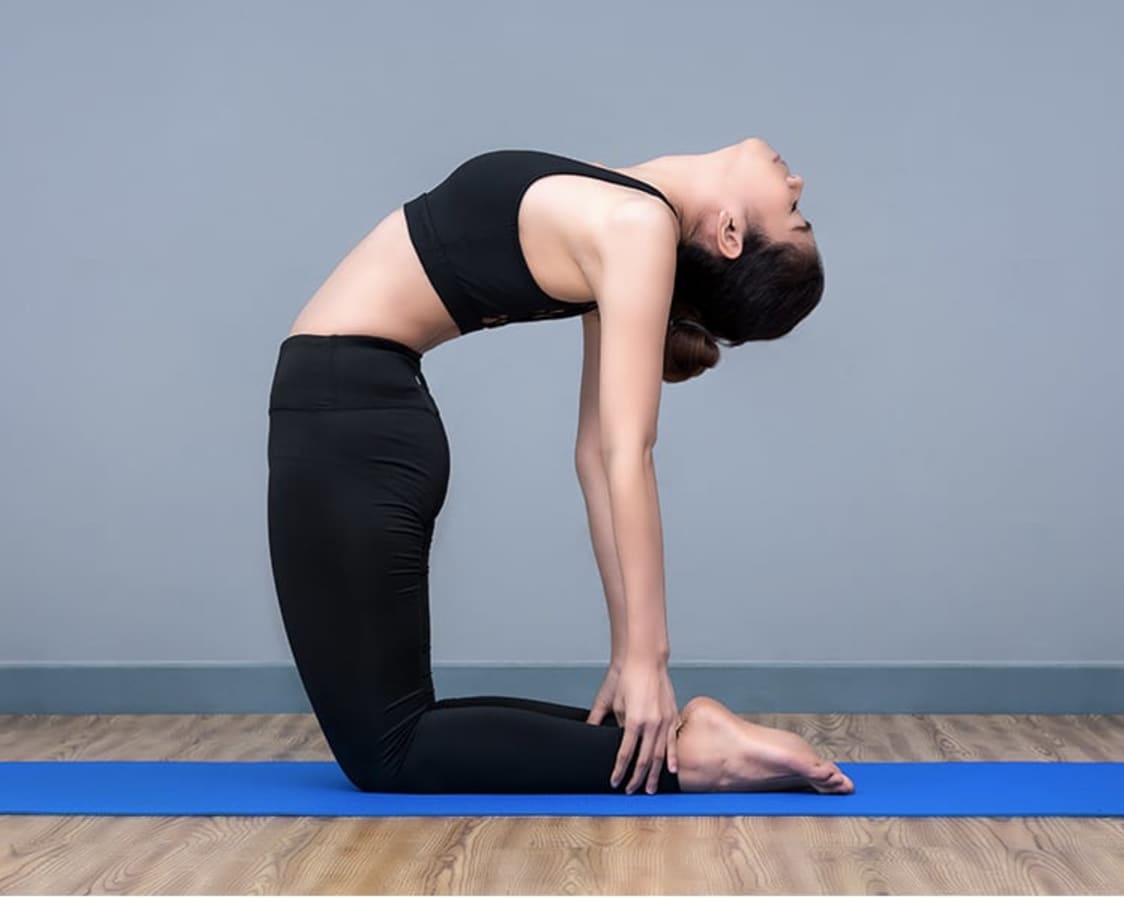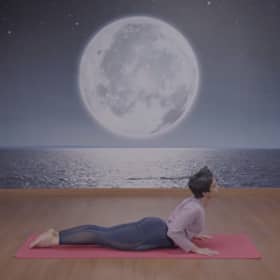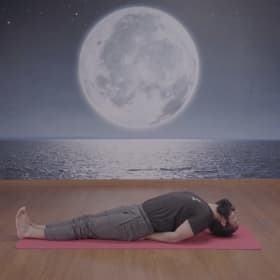
About this pack
4 Videos
What to expect from Back Bends?
Triyak Bhujangasana also known as the cobra pose is a great asana that also works as a stress reliever.
Benefits of Bhujangasana:
According to the information of Bhujangasana, it releases the built up stress in the muscles and brings the abdominal muscles into play. In addition to the abdominal muscles, it also works on the shoulders and the chest.
About other yoga poses:
The next yoga asana that you will be performing is the Shalabhasana. Now, this asana is similar in its benefits to the Bhujangasana but additionally it also works on the spine, buttocks and more. The last yoga asana of this workout pack is Ushtrasana, otherwise known as the Camel pose. One of the biggest benefits of this pose is that it helps with constipation in addition to relieving stress and working on the abdominal organs.
When to perform yoga:
You can practise these back bends any time of the day. All you have to do is to carefully listen to the instructions of our yoga instructor. Now, are you excited to begin your first session? Let’s get started then.
FAQs
Back Bends
What are Backbends?

Yoga is an ancient practice that helps bring the mind, soul, and body together. It consists of a series of poses called asanas. These asanas help stretch and tone your body and also heal and purify your body. There is no clear way to classify different yoga asanas, but they are based on their main physical orientation. Asanas in these categories have similar physical and energetic effects. The various yoga asana categories include standing yoga poses, backbend yoga poses, seated yoga poses, back yoga poses, abdominal yoga poses, strong yoga poses, and balanced yoga poses. There are poses and forward bending yoga poses. Examples of yoga backbend variations are cobra poses and bujangasana. Practicing these poses will give you more flexibility in back bending. Performing a perfect backbend can be difficult at first, but regular yoga practice will soon allow you to master a variety of backbend yoga poses.
Who Can Do Backward Bending Asanas?

Just like other asanas, anyone can do back-bending asanas without too much difficulty. In fact, you may have accidentally performed the back crunch, as it is a natural form of bending and straightening that helps relieve back pain or body aches. Performing backbend yoga poses while paying attention to breathing techniques and being more aware of your body will enrich your entire experience. Some of the more popular supine poses among yoga enthusiasts include salabhasana, fish pose, and grasshopper pose. Yoga for digestion is also a good idea. There are multiple yoga poses that you can try to improve flexibility and increase mobility in the chest area and lumbar spine.
List of Best Backbend Asanas

Backward-bending yoga poses: 1. Anuvittasana (backstand) 2. Matsyasana (fish pose) 3. Salamba bhujangasana (sphinx pose) 4. Ustrasana (camel pose) 5. Ardha dhanurasana (pose pose) half body) (Eight-limb Pose) 6. Bhujangasana (Cobra Pose)
What are the Benefits of Doing Backbends?

Backbend yoga poses are slightly more difficult than other types of yoga poses such as sitting yoga poses, balancing postures, standing postures, and inversion yoga pose. However, it is the difficult aspect that encourages many people to give it a shot. It opens up your front body, increases blood circulation, and strengthens your heart. It also improves your flexibility and range of motion. Here are a few of the many advantages of incorporating backbends into your yoga practice: It relieves back pain. It aids in posture improvement. It helps to strengthen your back muscles. It elongates your hip flexors. It enhances your breathing. It promotes blood circulation. It expands your chest and shoulders. It lifts your spirits and stretches your abdominal muscles. It reduces anxiety.
What is Backbend Yoga?
Backbend poses in yoga improve your hip flexibility and also open up your front body. It has also been observed to improve the mobility of your thoracic and lumbar spine. If you have been experiencing mobility issues, practicing yoga asanas is a great way to get more flexible and improve your range of motion. Backbend Yoga asanas need to be balanced with equal intensity and quantity of forward-bend yoga poses to get all the benefits it offers. If you lead a sedentary lifestyle or spend most of your time behind a desk, you may find most of the back bends to be challenging. Fortunately, it gets easier with practice. In no time you will be able to do the Fish pose or the matsyasana like a seasoned yoga expert. There are several different types of back bend yoga poses that you can try to improve your flexibility and increase the mobility of your thoracic and lumbar spine.
How Effectively Can We Do Back bends Workout at Home?
Although backbend asanas are extremely beneficial to your body and mind, you need to practice them carefully. The back bend yoga pose can be effectively performed at home or anywhere else only after a proper warm-up session that involves stretching your hips, chest, and abdomen. Once you start doing back bends, you need to start with gentle asanas like Child’s Pose, followed by Tabletop pose, and then Cat Pose to help your body prepare. The Sphinx pose, Bridge Pose, and even the Locust Pose will help your body prepare itself for deeper backbend asanas by strengthening your arms, legs, and the back of your torso.
Who Should Avoid Backbend Yoga Workouts?
If you have any back or neck injury problems currently or in the past, you need to consult a doctor before proceeding with backbend yoga. Once you get the green signal from your doctor you can ease into back bends under the guidance of an experienced yoga trainer.
List of Backbend Asanas
Let’s take a look at some of the different backward bend yoga asanas:
Anuvittasana (Standing Backbend)
Matsyasana (Fish pose)
Salamba bhujangasana (Sphinx Pose)
Ustrasana (Camel Posture)
Ardha dhanurasana (Half Locust Pose)
Salabhasana (Locust Pose)
Ashtangasana (Eight-Limbed Pose)
Bhujangasana (Cobra Pose)
While some of these back bends are meant for beginners, the others are considered advanced back bending asanas.
Anuvittasana (Standing Backbend)
While standing straight, place your palms with the fingers pointed downwards on your lower back.
Then press your feet towards the ground, squeeze your thighs and buttocks as you pull up your kneecaps.
Then press your hips forward, and slowly arch your torso backward. Keep looking forwards and use your arms and legs for support.
Breathe and hold this position for three to seven breaths before going back to the standing position slowly.
Total Time: 10 Minutes
Matsyasana (Fish Pose)
Lie down on your back with your arms on your sides and legs slightly apart.
Put your arms with your palms facing down under your thighs right below your buttocks and then lift your chest while arching your spine.
Remember to avoid using your head or neck for support while holding this pose.
Breathe slowly and hold this pose for three to eight breaths.
Then slowly remove the weight from your head and move back down to the floor.
Total Time: 10 Minutes
Salamba bhujangasana (Sphinx Pose)
Lie on your belly with your lower arms flat on the floor and your elbows under your shoulders. Keep your chin on the floor and your legs together.
Then press your lower arms into the floor as you inhale and lift your chest and head off the floor.
Remember to keep your neck and spine in line.
Then pull up your kneecaps while squeezing your buttocks and thighs as you press your pubic bone to the floor.
Then place your elbows by your side and use your arms to lift yourself higher.
Draw your chin inwards and gaze straight ahead.
Breathe and hold this pose for two to six breaths before exhaling and returning to the floor.
Total Time: 10 Minutes
Ustrasana (Camel Posture)
After the Child Pose, place your knees hip-width apart with your hands on the lower back with fingers pointed downwards.
Then inhale slowly and press your knees down and lengthen your spins.
Exhale slowly and press your hips forwards while squeezing your thighs and buttocks as you support your body with your arms.
Then slowly place one hand on each heel. If this is not possible, place your hands on your lower back.
Then press your hips forward as you lift your chest towards the ceiling.
Breathe and hold this pose for three to six breaths.
Total Time: 10 Minutes
Ardha Dhanurasana (Half Locust Pose)
Lie on your belly on the floor with your chin to the floor, arms on your sides, and legs together.
Then rock your hips side to side to move your arms underneath your boy in such a way that your hands are on your thighs and your forearms are along the side of your hip bone.
Inhale slowly and lengthen your legs with your toes away from your body.
Then pull up your kneecaps, while squeezing your buttocks and thighs.
Then press your arms downwards and gradually lift your legs towards the sky or ceiling.
Breathe and hold this pose for two to five breaths before exhaling and returning to the floor.
Total Time: 10 Minutes
Salabhasana (Locust Pose)
Lie down on your belly with your arms by your side, forehead on the floor, and your palms facing upwards
Then turn your big toes so that you rotate your thighs inwards.
Then squeeze your buttocks and press your pubic bone to the floor.
Then exhale slowly and lift your upper body, head arms, and legs. You need to support your body on your belly, lower ribs, and front pelvis.
Then squeeze your buttocks and reach through your legs and lengthen your back legs with your big toes turned inwards.
Then raise your arms and stretch back and push up towards the ceiling.
Gaze slightly upwards as you keep your head lifted and neck long.
Breathe and hold this pose for thirty seconds to a minute before exhaling.
Total Time: 10 Minutes
Ashtangasana (Eight-Limbed Pose)
After the Dog pose, gradually exhale and lower your chest and chin to the floor with your palms on either side of your chest.
Then place your elbows close to your sides and press your chest towards the floor while you lift your tailbone towards the sky or the ceiling.
Then breathe and hold this pose for two to four breaths.
Exhale slowly and return to the Dog pose
Total Time: 8 Minutes
Bhujangasana (Cobra Pose)
Lie on your belly on the floor with your chin on the floor and your palms flat while your legs and shoulders are together.
Then pull your kneecaps up while squeezing your thighs and buttocks as you press your pubic bone to the floor.
Inhale and then slowly lift your chest and head off the floor without using your arms.
Breathe and hold this bhujangasana pose for two to six minutes and exhale.
Total Time: 8 Minutes
Dos & Don’ts
Keep your feet grounded while doing backward bending asanas.
Bring your limbs towards your midline to strengthen your core.
Practice the Belly Lock pose by pulling your navel inwards and upwards.
Practice safe backbend yoga asanas by relaxing your shoulders and slow down your back.
Work on maintaining an even arch over your whole spine while practicing back bends.
Don’t strain your neck while performing the Ustrasana pose.
Don’t move in or out too quickly from backbend yoga poses.
Things Required to Do Backward Bending Asanas if You Are at Home & Gym?
The best thing about backward bending asanas is that they can be done whether at a gym or in the comfort of your home.
Like other yoga asanas, backbend yoga does not require any special equipment except maybe a yoga mat.
If you are doing backbend yoga for the first time, it is advisable to do it under the tutelage of an experienced yoga trainer.
Back bends require a lot of patience. So be ready to work on your technique before you are finally able to execute a perfect backbend yoga asana.
At the end of the day, backbend yoga asanas offer you a lot of advantages besides improving your flexibility. With sedentary lifestyles being more of a norm, you need to take up additional activities like yoga, running, and swimming to improve your physical health. These activities also boost your energy level and increase the production of happy hormones, allowing you to distress and find relief from constant anxiety. It is time to reclaim your body from the growing pains of age. Make back bends a part of your yoga routine to turn back time to a healthier and fitter body.
Top Searches
Cardio Exercises | Lean Muscle | Lean Body | Weight Loss Exercises | Six Pack Abs | HIIT Workout for Beginners | Exercise for Belly Fat | HRX Workout | Handstand Push Up | Online Fitness Trainer | How To Increase Stamina | Online Yoga Classes | Split Exercise | Workout For Beginners | Dumbbell Exercises | Pilates Workout | Walking Exercise | Pistol Squats | Oblique Exercises | Gym Near Me
Dentist Near Me | Gynaecologist Near Me | Dermatologist Near Me | Endocrinologist Near Me | Pulmonologist Near Me | Cardiologist Near Me | Orthopedist Doctor Near Me | Thyroid Test | Pregnancy Test | Full Body Checkup | Kidney Function Test | Lipid Profile Test | Therapist Near Me | Online Counselling | Physiotherapist Near Me
Sambar | Masala Dosa | Kadai Paneer | Manchow Soup | Chicken Soup | Paneer Masala | Chicken Keema | Badam Milk | Aloo Tikki Chaat | Moong Dal Kachori | Rasmalai | Pav Bhaji | Hummus | Chocolate Ice Cream | Mango Ice Cream | Mango Cake | Paneer | Macaroons | Chicken Biryani | Shawarma
Cult Gyms In India
Gyms In Delhi | Gyms In Mumbai | Gyms In Bangalore | Gyms In Pune | Gyms In Chennai | Gyms In Hyderabad | Gyms In Jaipur | Gyms In Kolkata | Gyms In Ahmedabad | Gyms In Chandigarh | Gyms In Indore | Gyms In Coimbatore | Gyms In Surat | Gyms In Ludhiana | Gyms In Vizag | Gyms In Amritsar | Gyms In Mysore | Gyms In Mangalore | Gyms In Kochi | Gyms In Jammu | Gym In Kharghar | Gym In Bandra | Gym In Velachery | Gym In Chembur | Gym In Indiranagar | Gym In HSR Layout
Types of Gyms by Cult.fit





